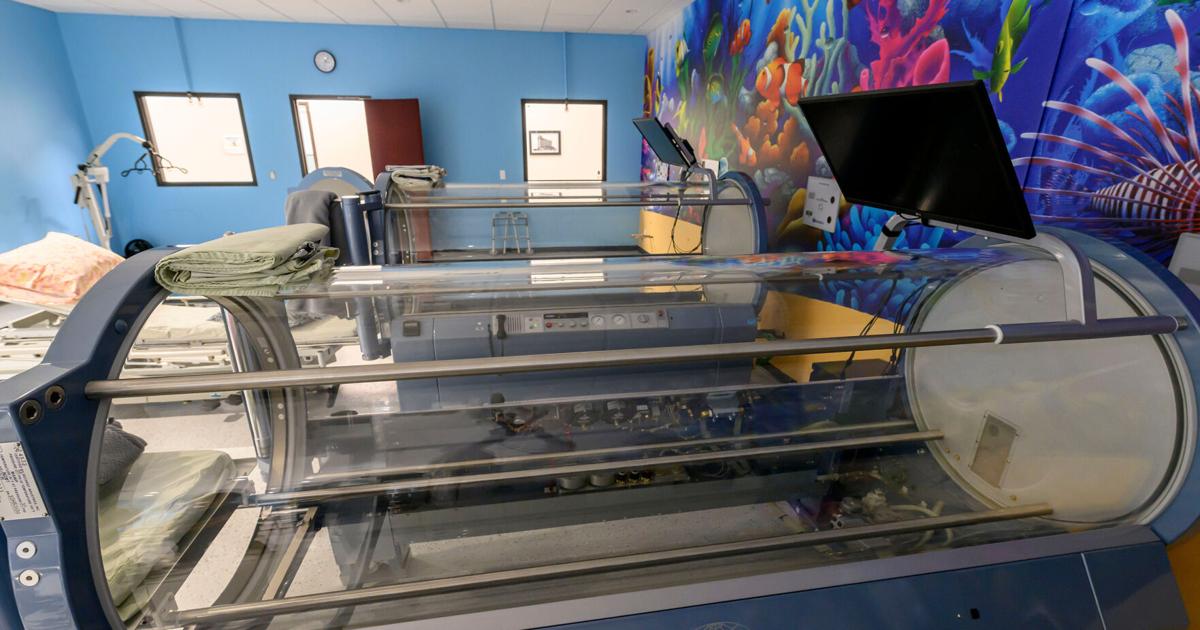By Anna Claire Vollers,Anna Claire Vollers | Missouri Independent
Copyright stltoday

Anna Claire Vollers | Missouri Independent
Just before 8 a.m. on Jan. 31, an explosion rocked a nondescript one-story office building in an affluent suburb of Detroit.
The building was home to The Oxford Center, a health clinic that provided hyperbaric oxygen therapy to treat a variety of disorders.
Inside the clinic, a spark had ignited the high-pressure, pure-oxygen atmosphere in a hyperbaric chamber where 5-year-old Thomas Cooper lay with a pillow and blanket, receiving treatment for ADHD and sleep apnea. A fireball consumed the inside of the chamber in seconds, killing the boy, law enforcement later said.
His mother suffered third-degree burns on her arms as she tried to free her son.
Within weeks of the tragedy, Michigan Democratic Attorney General Dana Nessel charged three Oxford Center employees, including the center’s owner, with second-degree murder and involuntary manslaughter, and a fourth employee with involuntary manslaughter. Nessel said the staff disregarded multiple safety protocols.
The Michigan death and another fatality less than six months later at a wellness clinic in Arizona have thrown a spotlight on the largely unregulated world of hyperbaric oxygen therapy. A treatment once primarily confined to hospitals, it has surged in popularity in alternative health spaces in recent years.
About 1,200 hyperbaric medicine programs operate in the United States, according to estimates from the Undersea and Hyperbaric Medical Society, a nonprofit organization recognized by the U.S. Food and Drug Administration as an accrediting body for hyperbaric oxygen therapy. Of those, 140 are accredited by the organization.
While nearly a dozen states require hyperbaric oxygen chambers to comply with certain safety standards, no states have comprehensive requirements specifically for accreditation or inspection of HBOT facilities.
Wellness clinics, sometimes without physician supervision, use the pressurized chambers for off-label treatments — those not approved by the FDA.
Before the explosion that killed Thomas Cooper, Michigan state Sen. Stephanie Chang had never heard of hyperbaric oxygen therapy. The Oxford Center is located in her district, just a block from where she takes her daughter for tutoring, she said.
Chang, a Democrat, was aghast when she learned the state doesn’t accredit or regularly inspect clinics that offer the therapy. It doesn’t even track where such clinics operate.
“I think many people in the community felt the same way,” she said. “This is happening in our community without any regulation? We’ve got to do something.”
Earlier this year, U.S. Health and Human Services Secretary Robert F. Kennedy Jr. visited wellness podcaster Gary Brecka at his home, where they hung out in a hyperbaric oxygen chamber before taping an episode of Brecka’s show.
Hyperbaric oxygen therapy has found a support network inside Kennedy’s Make America Healthy Again movement, among wellness influencers and anti-aging gurus. Podcasters including Brecka and Joe Rogan have touted the benefits of the chambers, while a hyperbaric chamber manufacturer had a presence at this year’s MAHA Spring Gala in Florida.
Before Trump’s reelection, Kennedy said in a social media post that the “FDA’s war on public health” was about to end, and he criticized its “aggressive suppression” of alternative health treatments, including hyperbaric therapy.
In hyperbaric oxygen therapy, also known as HBOT, patients rest inside a special chamber where they breathe pure oxygen. The air pressure in the chamber is raised to a level higher than normal to help increase the amount of oxygen in the blood to in turn accelerate healing.
Modern HBOT has been used for decades and is approved by the FDA to treat more than a dozen conditions, including burns, carbon monoxide poisoning and non-healing diabetic wounds.
Last month, in the wake of the Michigan and Arizona deaths, the FDA issued recommendations for HBOT providers and facilities to help reduce safety risks.
But as the wellness industry has ballooned, HBOT has seen “an exponential increase” in nonmedical providers, said John Peters, executive director at the Undersea and Hyperbaric Medical Society.
Wellness clinics like The Oxford Center in Michigan advertise that HBOT can treat a multitude of conditions off-label, from cancer and HIV to dementia and autism. Scientific research has been inconclusive. For example, some studies have shown benefits for children with autism, while others have found insufficient evidence to recommend it as a treatment.
Peters believes much of the off-label claims are exaggerated.
“There are people with discretionary income willing to spend it on these sales pitches,” said Peters. “What’s more sad than that are the people who are vulnerable. These are individuals who have sick family members or are sick themselves and they’re grasping at straws, looking for any relief. And they are tricked by these carpetbaggers.”
Most insurance plans will cover HBOT for FDA-approved uses, including the treatment of burns or carbon monoxide poisoning. Medicare, Medicaid and Tricare — the health insurance for active-duty and retired members of the military — also have a short list of approved conditions. For everything else, it’s cash-only.
And HBOT typically isn’t a one-and-done treatment. It can cost $200 or more per treatment session, with dozens of sessions recommended. Thomas Cooper had been on his 36th of 40 treatments for attention-deficit/hyperactivity disorder (ADHD) and sleep apnea, the Detroit Free Press reported. The FDA has not approved HBOT for either condition.
Unaccredited clinics like The Oxford Center are “making a lot of money and they have no one overseeing them,” said Michigan Democratic state Rep. Sharon MacDonell, who also represents the district where The Oxford Center was located and is working with Chang on a bill to regulate HBOT.
“No health insurance company is asking for documentation, no system is checking in. No state has figured out a way to do this, so we’re trying really hard.”
States in the dark
Deaths in hyperbaric chambers are rare, but the Michigan incident was one of two fatalities this year: In July, Walter Foxcroft, a 43-year-old physical therapist, was killed in an apparent flash fire in a hyperbaric chamber at his wellness clinic in Lake Havasu City, Arizona, according to municipal officials. First responders found him dead inside an intact chamber that appeared to have been on fire.
There have been other deaths and injuries over the past two decades.
In 2009, a 4-year-old boy and his 62-year-old grandmother died in a fire when a chamber exploded at a Florida clinic. That clinic, like the ones in Michigan and Arizona, was not accredited.
In 2023, a hyperbaric oxygen chamber exploded at a wellness spa in Utah, seriously injuring the two people inside, according to local fire officials. And in 2012, a hyperbaric chamber at a veterinary center in Florida exploded, killing the horse inside and a woman who had been operating the unit.
Nearly a dozen states require hyperbaric oxygen chambers to comply with certain safety standards for pressure vessels laid out by the American Society of Mechanical Engineers.
But Peters, with the Undersea and Hyperbaric Medical Society, said a large number of hyperbaric chambers imported from countries such as China and Poland that don’t meet those standards. He said experts believe there could be 20,000 noncode compliant chambers operating in the United States.
That’s one reason he believes the recent FDA guidance for safe use of the chambers rings hollow.
“The FDA guidance does nothing to curb the proliferation of noncode compliant chambers into the country and the use of those chambers,” he said. “It does nothing to address the secondary market. You can buy a hyperbaric chamber and sell it to another individual without any requirement.”
Access vs. safety
Chang and MacDonell say they want to require accreditation for hyperbaric chambers and for the clinics that offer the therapy, including requiring a physician or other medical provider to oversee treatment.
But some people, including some autism advocates, have expressed concern that overregulation could hurt access to HBOT for families that want it.
“I think these folks recognize they want to keep access but don’t want people getting taken advantage of by bad actors in this space, and want to ensure they’re going to a facility that’s doing things the right way,” Chang said.
Chang said the bill would not regulate a newer, more portable type of hyperbaric chamber that are popular in wellness circles and sometimes used in homes. They have soft outer shells and seal with a zipper, unlike traditional steel-cased chambers. The soft-side chambers provide so-called mild hyperbaric oxygen therapy at lower pressure and aren’t considered medical devices like hard-shell chambers. But in North Carolina, state fire marshals have shut down the use of such devices at wellness clinics over safety concerns.
Fire officials in other states, including Utah, have also expressed concerns over the soft-side chambers.
In recent years, veterans groups have pushed for HBOT to be available and covered for treating traumatic brain injury and post-traumatic stress disorder. Thirteen states have passed legislation to require or support such treatments for veterans, according to Eric Koleda, national director of state legislative efforts for TreatNOW, a coalition that promotes HBOT access for veterans.
Koleda said he’s glad the Michigan lawmakers are working on the issue, though he’s not convinced stricter regulation is needed.
“We’re not proposing that there needs to be an enormous amount of regulation because there are already safety standards in place, and if they’re adhered to, that ensures a safe level of operation,” he said. “This is treatment that’s already done safely every day.”
In July, Missouri Republican Gov. Mike Kehoe signed a bill into law establishing a fund to pay for HBOT for veterans with a traumatic brain injury or PTSD. The bill passed with overwhelming bipartisan support in the legislature.
Veteran-related HBOT bills have also been introduced this year in Indiana, Iowa, Kentucky, New Jersey, New York and Oregon. Koleda said his organization is also working to get the FDA and the Centers for Medicare & Medicaid Services to add traumatic brain injury and PTSD to the list of conditions approved for HBOT treatment.
Indiana state Sen. David Niezgodski, a Democrat, introduced a resolution in April urging the state’s legislative council to study regulation of HBOT. The deaths in Michigan and Arizona caught his eye, he said, because Indiana has a law promoting the treatment for veterans. The resolution passed but wasn’t taken up by the council.
“I am 100% for trying to do everything we can to get this treatment where those who need it are truly able to benefit from it,” he told Stateline. “Though I want to be certain that we do everything we can to make sure that when they receive that treatment, it’s going to be safe at all times.”
The Michigan lawmakers stress their bill doesn’t restrict HBOT’s off-label use and they’re continuing to work with stakeholders. They hope to get it filed before the end of the year.
“When you go into what you believe to be a medical facility, you assume it is being regulated and that it is licensed and that the people running this complex technology know what they’re doing,” said MacDonell. “That’s our goal.”
Stateline reporter Anna Claire Vollers can be reached at avollers@stateline.org.
Missouri Independent is part of States Newsroom, a nonprofit news network supported by grants and a coalition of donors as a 501c(3) public charity. Missouri Independent maintains editorial independence. Contact Editor Jason Hancock for questions: info@missouriindependent.com.



